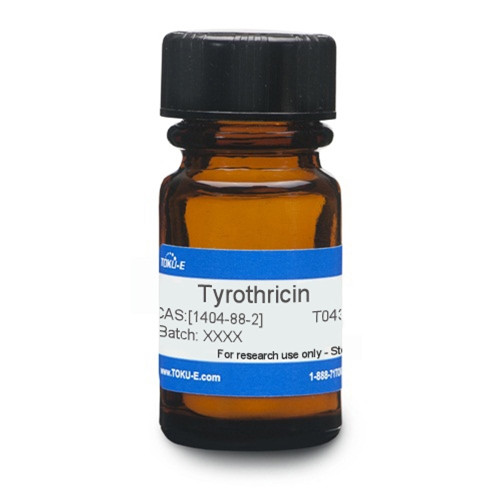Tyrothricin is a large cyclic polypeptide antibiotic isolated from Brevibacillus brevis in 1939. The name Tyrothricin is derived from Tyrothrix, a name first used by Duclaux to designate sporulating aerobic bacteria. Tyrothricin is composed of a mixture of tyrocidine and gramicidin, which are short polypeptides with antimicrobial activity. The complex is a mixture comprised of 60% Tyrocidine and 40% gramicidins. Tyrocidine is composed of non-ribosomally produced cationic cyclic decapeptides (the six predominant tyrocidines are TrcA/A1, TrcB/B1, TrcC/C1) and adopts a β-sheet structure with both L and D amino acids. Gramicidins adopt similar B-sheet structures, and are neutral linear, with valine-Gramicidin A often the major component. Tyrothricin is soluble in alcohol and insoluble in water.
| Mechanism of Action | Tyrothricin targets and inserts into the Gram-positive membrane where it disrupts normal permeability leading to cell death, but the exact mechanism is unclear. Tyrocidines appear to act as reversible inhibitors of acetylcholinesterase and β-galactosidase. |
| Spectrum | Tyrothricin is effective against Gram-positive bacteria, fungi, and some viruses. It has bacteriocidal activity. The antifungal activity is dictated by the primary sequence of the tyrocidine. |
| Molecular Formula | C65H85N11O13 |
| Microbiology Applications | An interesting property of antimicrobial peptides (AMPs) is that even in vitro, it is nearly impossible to induce resistance. However, there are toxicity concerns, as the components of Tyrothricin can disrupt the eukaryotic cell membranes at high concentrations resulting in toxicity. |
| References |
Farmer SW et al (1996) Gramicidin S is active against both Gram-positive and Gram-negative bacteria. Int. J. Peptide and Protein Res. 47(6):460-466 Hotchkiss RD and Dubox RJ (1940) Bactericidal fractions from an aerobic sporulating bacillus. J. Biol. Chem. 136(3):803-804 Stauss-Grabo M, Atiye S, Le T, Kretschmar M (2014) Decade-long use of the antimicrobial peptide combination Tyrothricin does not pose a major risk of acquired resistance with Gram-positive bacteria and Candida spp. Pharmazie. 69(11):838-841 PMID 25985581 Vosloo JA, Stander MA, Leussa AN, Spathelf BM, Rautenbach M (2013) Manipulation of the Tyrothricin production profile of Bacillus aneurinolyticus. Microbiology (Reading). 159(Pt 10):2200-2211 PMID 23963303 |



